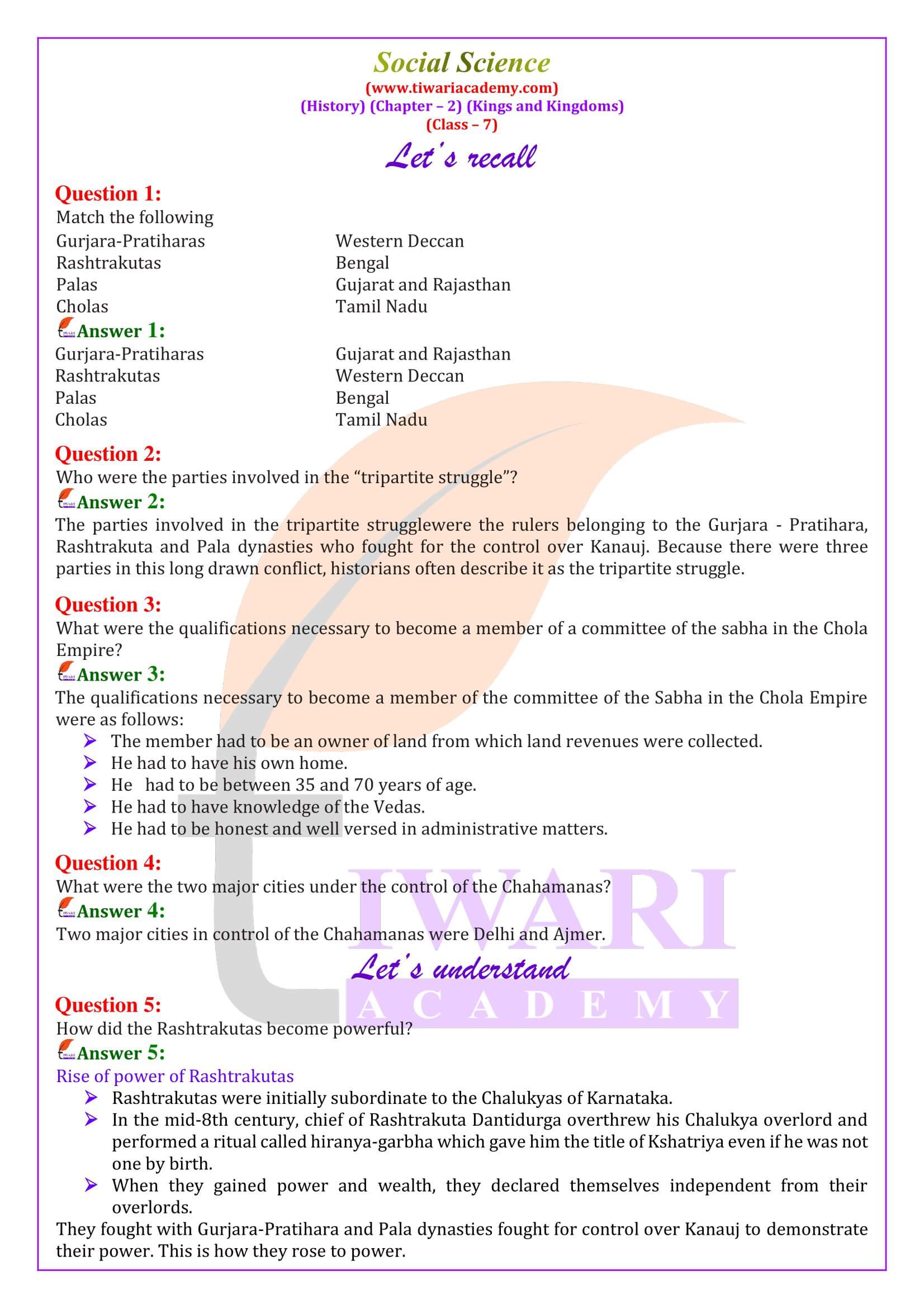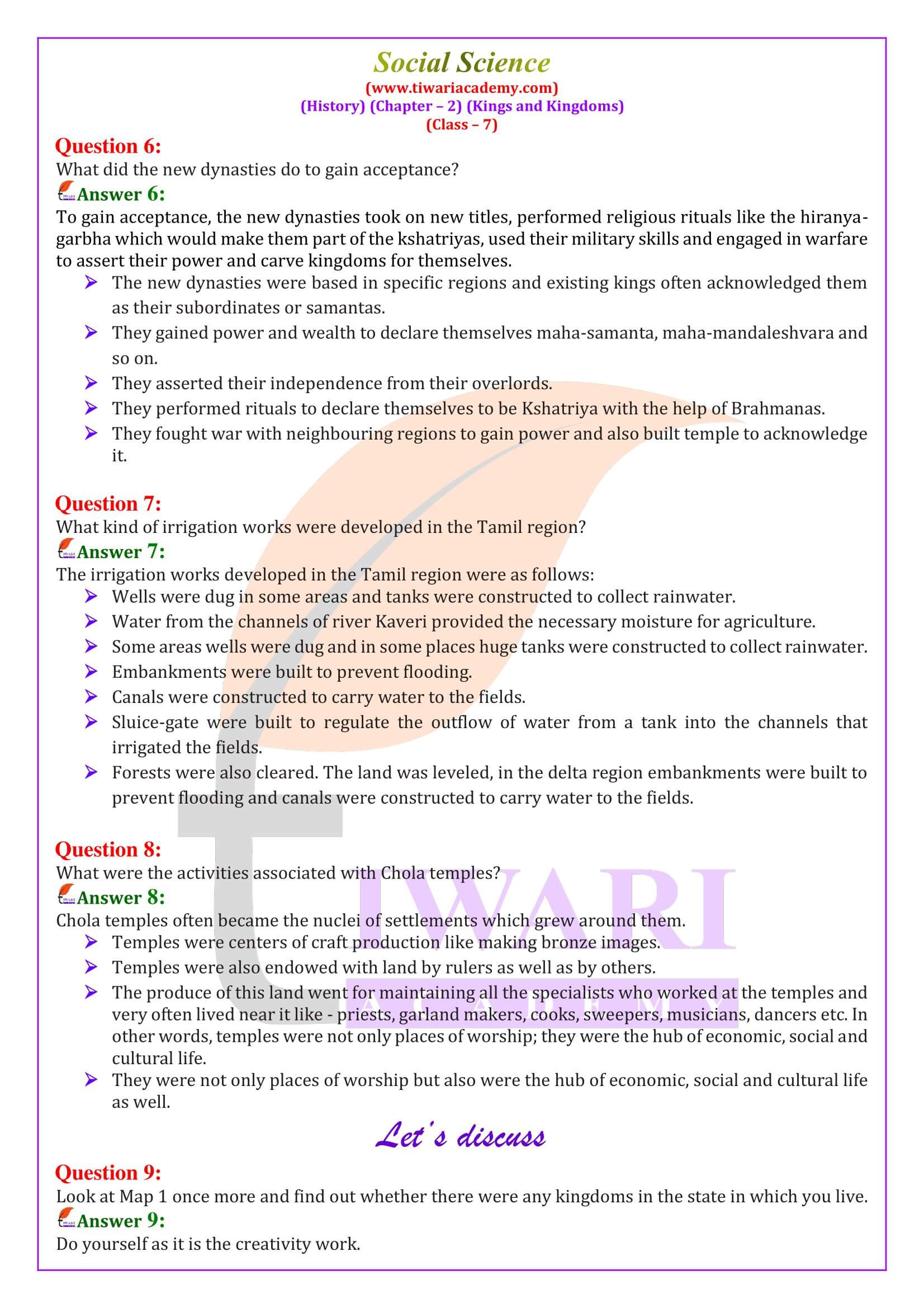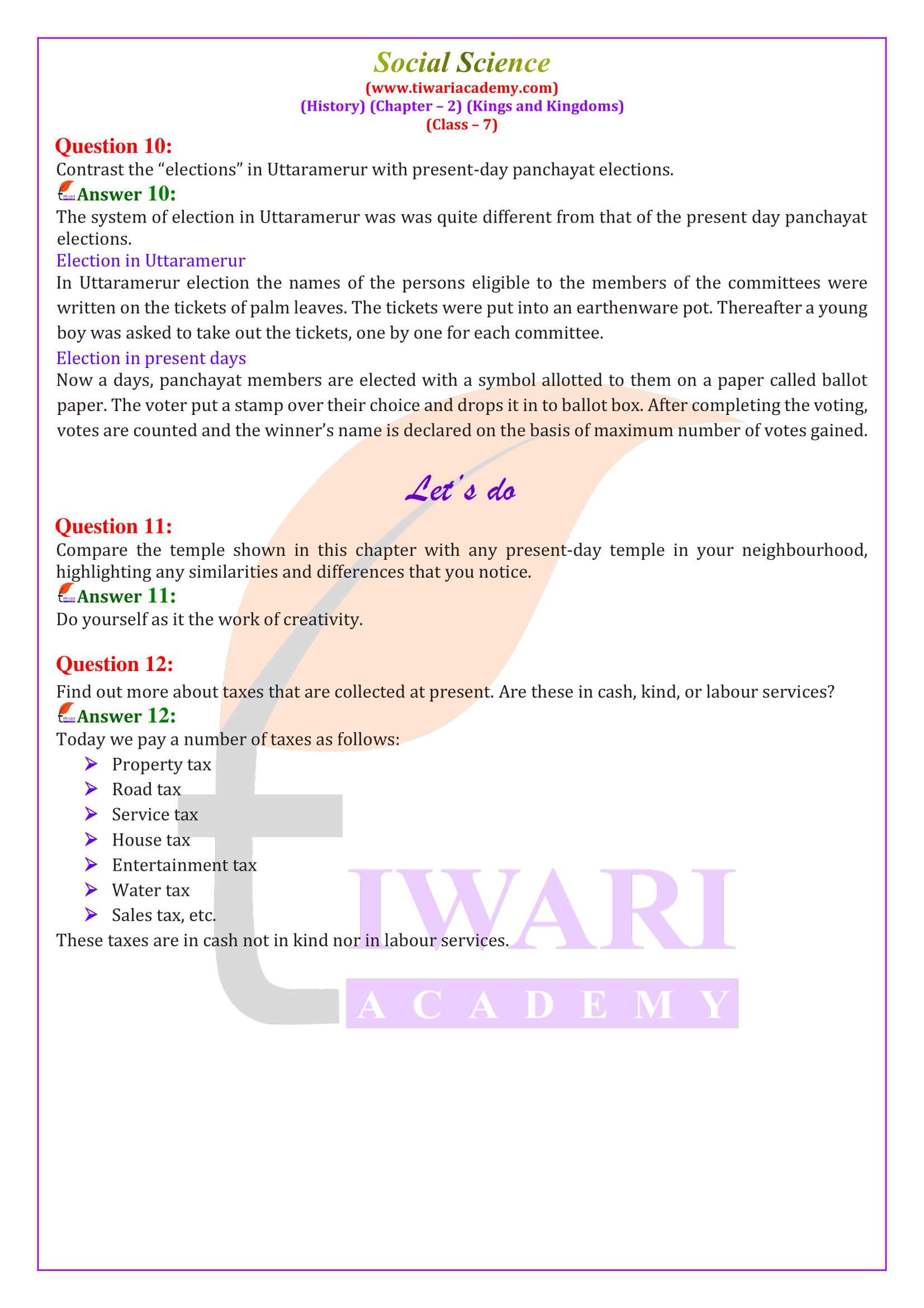NCERT Solutions for Class 7 Social Science History Chapter 2 Kings and Kingdoms in English Medium and Hindi Medium free to View online or download in PDF format updated for new academic session 2025-26. All the NCERT Solutions 2025-26 are based on latest CBSE Books for the new academic session 2020–2021. Offline apps based on these NCERT Books are also in updated format.
NCERT Solutions for Class 7 Social Science History Chapter 2
| Class: 7 | History |
| Subject: | Social Science |
| Chapter 2: | Kings and Kingdoms |
| Academic Session: | 2025-26 |
| Medium: | English and Hindi Medium |
Class 7 History Chapter 2 Question Answers
CBSE NCERT Solutions for Class 7 Social Science History Chapter 2 Kings and Kingdoms is given below in Hindi and English Medium updated format for session 2025-26. Download these solutions and Class 7 all Subjects apps are available to use as it without downloading online.
Class 7 History Chapter 2 in English Medium
Important Notes on 7th History Chapter 2
By the seventh century there were big landlords or warrior chiefs in different regions of the subcontinent. Existing kings often acknowledged them as their subordinates or samantas.
As samantas gained power and wealth, they declared themselves to be maha-samanta, maha-mandaleshvara (the great lord of a “circle” or region) and so on. Sometimes they asserted their independence from their overlords.
Many of these new kings adopted high-sounding titles such as maharaja-adhiraja (great king, overlord of kings), tribhuvana-chakravartin (lord of the three worlds) and so on.
In each of these states, resources were obtained from the producers – that is, peasants, cattle-keepers, artisans – who were often persuaded or compelled to surrender part of what they produced. Sometimes these were claimed as “rent” due to a lord who asserted that he owned the land. Revenue was also collected from traders.
Construction of Temples
These resources were used to finance the king’s establishment, as well as for the construction of temples and forts. They were also used to fight wars, which were in turn expected to lead to the acquisition of wealth in the form of plunder, and access to land as well as trade routes.
Prashastis contain details that may not be literally true. But they tell us how rulers wanted to depict themselves – as valiant, victorious warriors, for example. These were composed by learned Brahmanas, who occasionally helped in the administration.
Unusual for the twelfth century was a long Sanskrit poem containing the history of kings who ruled over Kashmir. It was composed by an author named Kalhana.
One of the best known of such rulers is Sultan
Mahmud of Ghazni, Afghanistan. He ruled from 997 to 1030, and extended control over parts of Central Asia, Iran and the north-western part of the subcontinent.
Sultan Mahmud was also interested in finding out more about the people he conquered, and entrusted a scholar named Al-Biruni to write an account of the subcontinent.
Class 7 Social Science – History Chapter 2 – Important Questions
Who were the parties involved in the “tripartite struggle”?
The parties involved in the tripartite strugglewere the rulers belonging to the Gurjara – Pratihara, Rashtrakuta and Pala dynasties who fought for the control over Kanauj. Because there were three parties in this long drawn conflict, historians often describe it as the tripartite struggle.
What were the qualifications necessary to become a member of a committee of the sabha in the Chola Empire?
The qualifications necessary to become a member of the committee of the Sabha in the Chola Empire were as follows: The member had to be an owner of land from which land revenues were collected. He had to have his own home. He had to be between 35 and 70 years of age. He had to have knowledge of the Vedas. He had to be honest and well versed in administrative matters.
What were the two major cities under the control of the Chahamanas?
Two major cities in control of the Chahamanas were Delhi and Ajmer.
How did the Rashtrakutas become powerful?
Rise of power of Rashtrakutas Rashtrakutas were initially subordinate to the Chalukyas of Karnataka. In the mid-8th century, chief of Rashtrakuta Dantidurga overthrew his Chalukya overlord and performed a ritual called hiranya-garbha which gave him the title of Kshatriya even if he was not one by birth. When they gained power and wealth, they declared themselves independent from their overlords. They fought with Gurjara-Pratihara and Pala dynasties fought for control over Kanauj to demonstrate their power. This is how they rose to power.
What did the new dynasties do to gain acceptance?
To gain acceptance, the new dynasties took on new titles, performed religious rituals like the hiranya-garbha which would make them part of the kshatriyas, used their military skills and engaged in warfare to assert their power and carve kingdoms for themselves. The new dynasties were based in specific regions and existing kings often acknowledged them as their subordinates or samantas. They gained power and wealth to declare themselves maha-samanta, maha-mandaleshvara and so on. They asserted their independence from their overlords. They performed rituals to declare themselves to be Kshatriya with the help of Brahmanas. They fought war with neighbouring regions to gain power and also built temple to acknowledge it.
What kind of irrigation works were developed in the Tamil region?
The irrigation works developed in the Tamil region were as follows: Wells were dug in some areas and tanks were constructed to collect rainwater. Water from the channels of river Kaveri provided the necessary moisture for agriculture. Some areas wells were dug and in some places huge tanks were constructed to collect rainwater. Embankments were built to prevent flooding. Canals were constructed to carry water to the fields. Sluice-gate were built to regulate the outflow of water from a tank into the channels that irrigated the fields. Forests were also cleared. The land was leveled, in the delta region embankments were built to prevent flooding and canals were constructed to carry water to the fields.
What were the activities associated with Chola temples?
Chola temples often became the nuclei of settlements which grew around them. Temples were centers of craft production like making bronze images. Temples were also endowed with land by rulers as well as by others. The produce of this land went for maintaining all the specialists who worked at the temples and very often lived near it like – priests, garland makers, cooks, sweepers, musicians, dancers etc. In other words, temples were not only places of worship; they were the hub of economic, social and cultural life. They were not only places of worship but also were the hub of economic, social and cultural life as well.
Contrast the “elections” in Uttaramerur with presentday panchayat elections.
The system of election in Uttaramerur was was quite different from that of the present day panchayat elections. Election in Uttaramerur In Uttaramerur election the names of the persons eligible to the members of the committees were written on the tickets of palm leaves. The tickets were put into an earthenware pot. Thereafter a young boy was asked to take out the tickets, one by one for each committee. Election in present days Now a days, panchayat members are elected with a symbol allotted to them on a paper called ballot paper. The voter put a stamp over their choice and drops it in to ballot box. After completing the voting, votes are counted and the winner’s name is declared on the basis of maximum number of votes gained.
Find out more about taxes that are collected at present. Are these in cash, kind, or labour services?
Today we pay a number of taxes as follows: Property tax Road tax Service tax House tax Entertainment tax Water tax Sales tax, etc. These taxes are in cash not in kind nor in labour services.




